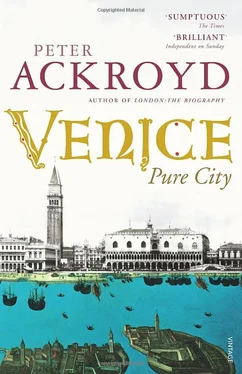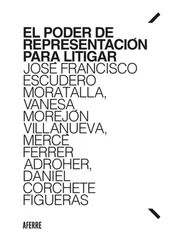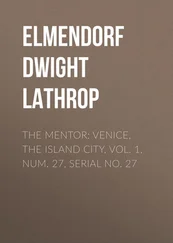There was a pattern to their movement. The people of Altino migrated to Torcello and Burano, for example, while those from Treviso went to Rialto and Malamocco. The inhabitants of Padua sailed to Chioggia. The citizens of Aquileia moved to Grado, which was itself protected by marshes. They came with craftsmen and builders, with farmers and labourers, with patricians and plebeians; they came with the sacred vessels from their churches, and even with the stones of their public buildings so that they might build anew. But how could they build on such shifting ground? How could they build upon mud and water? It was possible, however, for wooden poles of from ten to a dozen feet in length to be sunk into the mud before reaching a layer of harder clay and dense sand that acted as a firm foundation. This was the “boundary” at the bottom of the lagoon. So there sprang up small houses known as casoni made from the wood of poles and boards, with pitched roofs of wattle and reed.
New towns, such as Heraclea and Equilio (Jesolo), were founded by the edge of the lagoon. On the islands were established village communities, with leaders consulting assemblies of the people. The Veneti may also have set up fortified encampments, in the event that the Huns or Goths decided to move against them. But the islanders were fractious and competitive; there was no unity in the lagoons. So in 466, just twenty years after the appearance of Attila, a meeting of all the Veneti of the lagoon was held at Grado. It was decided that each island would be represented by a tribune, and that the tribunes would then work together for the common good. They were, after all, facing the same dangers and difficulties—not least from the depredations of the sea. This was the first sign of the public and communal spirit that would one day manifest itself so clearly in Venice itself.
The Veneti were by the sixth century a defined presence in the region. They were paid to ferry people and goods between the ports and harbours of the mainland. They transported the soldiers of Byzantium from Grado to the river Brenta. They carried officials and merchants to Byzantium itself. Already they were known for their maritime skills. Their boats travelled up the rivers of northern Italy, trading salt and fish to the cities and villages en route.
The first description of these island people comes in a letter sent in 523 to their tribunes by a legate from the Ostrogoth kingdom then prevailing in northern Italy. Cassiodorus was asking them to transport wine and oil across the waters to Ravenna. “For you live like seabirds,” he wrote, “with your homes dispersed, like the Cyclades, across the surface of the water. The solidity of the earth on which they rest is secured only by osier and wattle; yet you do not hesitate to oppose so frail a bulwark to the wildness of the sea.” He was not quite accurate in his description; there were already some houses constructed from the stone and brick of the mainland. He went on to say that the Veneti “have one great wealth—the fish which suffices for you all. Among you there is no difference between rich and poor; your food is the same, your houses are all alike.” Again, this was not quite true. Extant testimonials suggest that, even at an early stage in the development of the lagoon, there were rich as well as poor families. Cassiodorus then added that “your energies are spent on your salt fields; in them indeed lies your prosperity.” In this, at least, he was right. And he added the significant detail of “your boats—which like horses you keep tied up at the doors of your dwellings.” By good fortune one of these boats has emerged from the mud of the lagoon. Part of a rib of oak, and a hull of lime, have been found on the island of S. Francesco del Deserto; the boat itself dates to the fifth century. It was lying at a level that, in this period, would have been submerged except at times of low tide.
Yet Venice itself was not yet born. It is not shown in a fourth-century map of the region, in which the lagoon is depicted as a sea route without people. Venetian historians claimed, however, that the city was established at midday on 25 March 421, by a poor fisherman known as Giovanni Bono or John the Good. There are advantages to this theory, since the same date has been given to the vernal equinox, the Annunciation and the supposed date of the foundation of Rome. The triple coincidence, as well as the provident arrival of John the Good, is too good to be true; but it is part of the extraordinary Venetian ability to supplant history with myth. As the German poet, Rilke, said on a visit to the city in 1920, “as with mirrors one grasps nothing but is only drawn into the secret of its elusiveness. One is filled with images all day long, but could not substantiate a single one of them. Venice is a matter of faith.”
In fact Venice emerged over a century later, after a series of invasions by the Lombards in the late 560s and early 570s. Once more the province of Venetia was overcome by alien tribes. Unlike the Huns, however, they did not wish to plunder and depart. They intended to stay and to settle. They overran what is now called in their name the region of Lombardy. Their arrival prompted a mass exodus of the Veneti. The bishop of Aquileia moved his see to the edge of the lagoon at Grado. The bishop of Padua removed himself to Malamocco, and the bishop of Oderzo sailed to Heraclea. These men were secular as well as religious leaders; they took citizens as well as congregations, ready to create new communities on the water. Burano and Murano were extensively settled, as well as smaller islands such as Ammiana and Constanziaca; these last two disappeared beneath the waves in the thirteenth century, swallowed up by the main enemy of the island people. They have never rested in their battle against the sea.
Venice was born in this flight from the Lombards. The most recent archaeological investigations have dated the first signs of human habitation to the second half of the sixth century and to the seventh century; these remains were situated in the neighbourhood of Castello, in the east of the city, and beneath Saint Mark’s Square. There is evidence, too, that in these early years work had already begun on raising the surface of the land and reclaiming earth from water. The settlers fenced the soil with planks and poles; they drained the water; they laid down building rubble, or sediment, or sand from the dunes; they erected wooden palisades to resist the sea. It is the beginning of the city.
The exiles had decided to settle on a favoured group of islands, midway in the lagoon, known collectively as the Rivoalto or the high bank. This eventually became the Rialto, the pre-eminent market-place and emporium of the city. The islands were interspersed with rivulets and water-courses but there was one larger river, a tributary of the Brenta known as the Rivoaltus; this became in time the Grand Canal. Two more solid hills or islands—their description depends entirely upon how you judge the nature of the territory—faced each other along the course of this river. This is where Venice was created. This was land where the exiles could build. It was not easy work. In 589 there are reports of catastrophic flooding throughout the entire region, the force of which was so great that the course of certain rivers was altered. The calamity would have changed the hydraulic structure of the lagoon, but its effects upon the emerging Venice are not known.
Venice did not immediately become the most important city of the lagoon. Grado was the seat of the patriarch; Torcello was the great emporium or market of the region. The ducal seat, as it became known, moved from Eraclea to Malamocco. In the period when Venice was first being settled, there were elaborate building works elsewhere. The basilica of S. Maria Assunta was then being built on Torcello; an inscription on that site is dated 639, and confirms that the church was erected within the context of Byzantine ritual and worship.
Читать дальше












